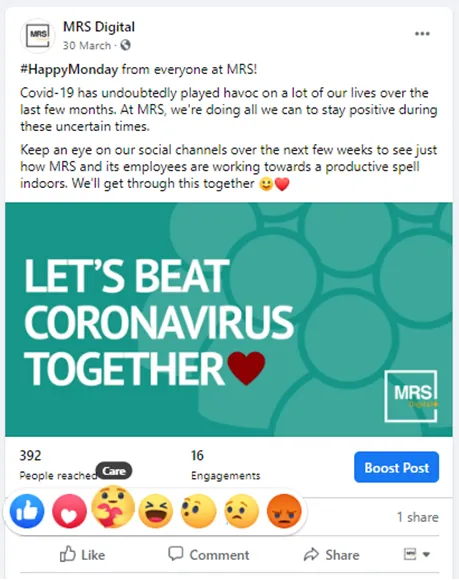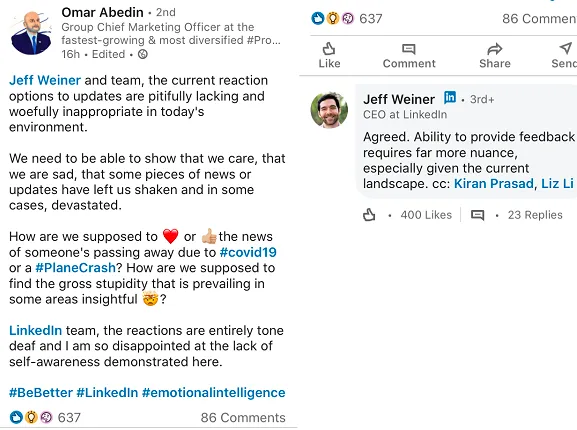Lockdown in March 2020 was an incredibly strange time for the world, and since then, we’ve all been presented with new challenges. As daily routines changed overnight, more of people’s daily and work lives shifted online, and social media became an even more important tool for communication than it was before.
Facebook’s changes due to COVID-19
Facebook made a series of changes to their platform throughout the COVID-19 pandemic to help spread correct information, keep users engaged, and improve the way we communicate.
Information centre panel
First of all, they announced the rollout of the COVID-19 information centre panel, which you may have noticed in early March at the top of your Facebook newsfeed. It was there to deliver users with the most up-to-date, official and correct news and developments on the pandemic.
Care reaction and a Messenger chatbot
Shortly after this, the platform began working on a COVID-19 themed reaction, which was rolled out to users as the ‘care’ reaction for both Facebook and Messenger. This provided users with a new quick-response option for COVID-19 related updates.

In April 2020, Facebook Messenger partnered with the World Health Organization to launch a new chatbot on Messenger, which provided users with accurate and up-to-date information about the COVID-19 pandemic. In addition to this, Facebook have also provided a new set of templates to help companies and brands communicate key business updates during this time.
Messenger Rooms
In light of the sudden extreme rise in video-chat demand, it was inevitable that Facebook would have to launch something similar. By May 2020, ‘Messenger Rooms’ was finally launched across Facebook and WhatsApp, enabling users to host video rooms, similar to Zoom, WebEx and Skype.
Messenger Rooms currently allows chat rooms with up to 50 people, and friends are able to see when you have a room ‘active’ at the top of their Facebook feed. This means that they can drop in if they want to join an active discussion.
Messenger Rooms are unique because no other free-to-use video-chat services allow this amount of people in one room. However, this was launched three months into the lockdown – was Facebook too late to the party with this one?
Instagram’s changes due to COVID-19
Evolved live streaming
During the COVID-19 lockdowns, live-streaming became more popular than ever. People were looking to replace their lost social interactions the best way they could, and the real-time engagement when streaming provided the closest alternative. In light of this, Instagram evolved live streams so that more than two people could enjoy them at once.
New stickers for stories
In March 2020, Instagram launched two new stickers for stories in line with the current circumstances during the time. ‘Thank You Hour’ and “I Stay at Home For’ stickers were both launched to encourage people to stay home and appreciate key workers. As explained by Instagram:
“Today we’re launching Thank You Hour, a sticker in stories that lets you show gratitude for what’s helping you through this time. Use the sticker and your photo or video will be added to a shared Instagram story at 7 p.m. your time, where friends can see your thanks.”
“Add the Stay Home sticker to your story, tap it and you’ll see the #IStayHomeFor option. From there, you can tag the people you love.”

Today we’re launching Thank You Hour ?
— Instagram (@instagram) April 10, 2020
It's a sticker in stories that lets you show gratitude for what's helping you through this time.
Use the sticker and your photo or video will be added to a shared Instagram story at 7 p.m. your time where friends can see your thanks ✨ pic.twitter.com/oyvfWEsZ9d
With the ongoing popularity of Instagram Stories and ephemeral content during this time, Instagram understands that its demographic is mostly the younger generation. From what the experts currently know, out of all age groups, COVID-19 is least threatening to the under 40s, so by creating content that encourages the younger generation to stay home, Instagram were doing all the right things to help combat the ongoing outbreak, early on.
Twitter’s changes due to COVID-19
Tips for brands
Twitter shared a tweet at the beginning of the April 2020 stating that they would be “offering their best tips for how to connect with your customers and your community during COVID-19.” In aid of this, the platform conducted and shared a user survey to shed some light on what people want and expect from brands and their communications during COVID-19. Some of the key findings were:
- 77% agreed they feel more positively about brands making an effort to support society
- 64% said brands should continue advertising products as normal
- 52% agreed that seeing/hearing ads gives them a sense of normality
- Only 7% of respondents said brands should continue using their normal brand tone of voice
This was great for giving brands guidance and stability during the most uncertain times, as a lot of companies and brands didn’t know if or how they should be changing their messaging during COVID-19.
LinkedIn’s changes due to COVID-19
In March 2020, LinkedIn outlined the steps they were taking to keep all their members informed about COVID-19.
Dedicated feed and banner
LinkedIn said that they aim to provide as many options as possible to keep members productive and positive during this pandemic. To help do this they have created a dedicated feed, which is regularly populated by the network’s 60-plus editors, with relevant content.
LinkedIn have also updated the banner on their homepage, which features government guideline reminders on what to do in the current pandemic.

Top Voices list
In April, LinkedIn published a special “Top Voices” listing of health professionals that were leading the way during the COVID-19 crisis. This section focused on highlighting the health experts who are sharing their knowledge and experiences amid the pandemic. As explained by LinkedIn:
“Each year, our Top Voices list surfaces the professionals whose posts, videos, articles and comments spark quality conversations in their industries. This special edition list features the health care experts that are lighting up LinkedIn right now to cover COVID-19 – sharing what they’ re seeing, what’s coming next and offering insights on what all of us can and must do.”
The list was released on World Health Day and aimed to pay respects and promote those working on the front line during these unprecedented times.
LinkedIn Events made available to all
Alongside the Top Voices list in April 2020, LinkedIn also made its ‘Events’ option available to all companies, in hope of helping with connectivity during lockdowns. LinkedIn Events is a fairly recent feature that was first launched to select company pages in October 2019. Now, however, you can access Events on any LinkedIn company page. To create your own event, you can head to your company page admin tools on desktop.
New reactions considerations
In May 2020, it had been highlighted that LinkedIn should consider some new reactions to express more emotive responses during COVID-19, similar to other social media platforms such as Facebook. After a LinkedIn user identified the lack of diversity within reactions, the CEO at LinkedIn, Jeff Weiner, responded to the comments agreeing.

LinkedIn launched its ‘Reactions’ feature in August 2019, with five different emoji responses to choose from, enabling you to quickly share how you feel about each post and update, but not giving you much choice on different feelings. As Omar Abedin notes, none of those are really fit for the COVID-19 stories that currently dominate LinkedIn’s feed. As such, LinkedIn could look to add in a new reaction type, which is what Facebook did with its ‘Care’ Reaction, launched in April 2020.
How other platforms evolved during COVID-19
Although we saw our main platforms evolve during this year’s global pandemic, we also saw so many other platforms skyrocket in downloads and make big changes to adapt to lockdown life.
Video chat social platform Zoom had a record-breaking April 2020 with 131 million downloads worldwide, according to data released by Sensor Tower. Zoom was the most downloaded “non-game” app in the world in April 2020 across both Android and iOS.
Alongside this, the social media app TikTok was seemingly thriving during the global lockdowns. The social media platform hit 2 billion downloads globally by the end of April 2020, in which it was downloaded 315 million times in this year’s first quarter alone.
It’s safe to say 2020 has brought us all many unexpected changes. It’s been interesting to see how, digitally, this year we have adapted with the times; staying more connected than ever even if we are all at home. It will also be exciting to see how we continue to evolve digitally. Will working from home become the new normal? Will zoom meetings eventually phase out, or will they become a vital long-term communication tool? We’re yet to find out.






